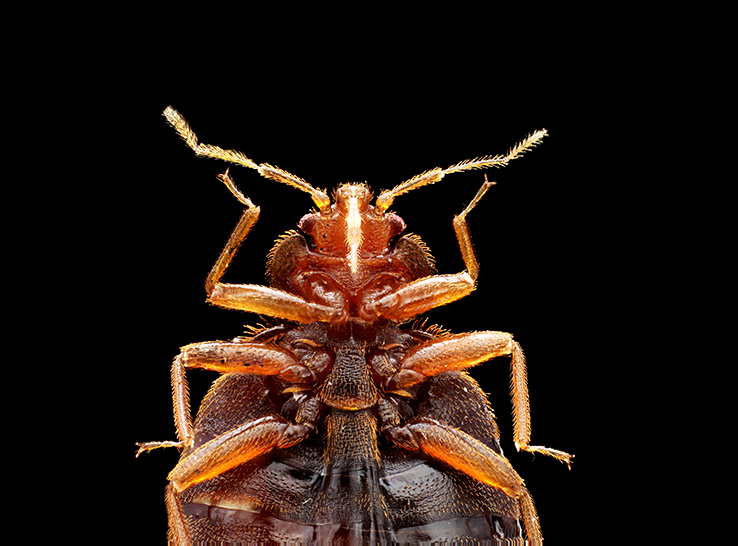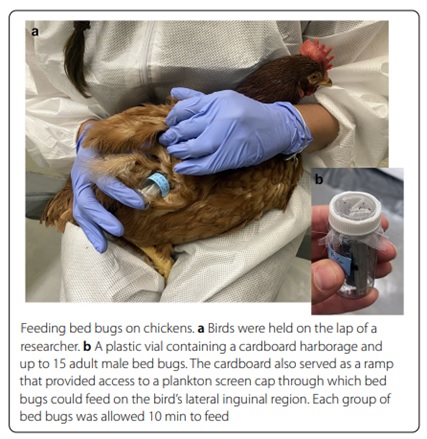 While there’s almost no research on bed bugs’ impact on poultry health, it’s reasonable to expect that the biting and blood-feeding associated with infestations can cause stress, infections, anemia, secondary diseases and a decline in production.
While there’s almost no research on bed bugs’ impact on poultry health, it’s reasonable to expect that the biting and blood-feeding associated with infestations can cause stress, infections, anemia, secondary diseases and a decline in production.
“Unfortunately, there are limited products labeled for bed bug control,” says Jim Stockam, DVM, a veterinarian at Merck Animal Health. “And bed bugs have developed resistance to a broad spectrum of active ingredients used in the past.”1
Pyrethroids are the primary class of insecticides used to control bed bugs in poultry farms. However, pyrethroid resistance is widespread in the populations worldwide, and knockdown resistance has increased in the last decade.2 Ibid That means that poultry farms will face highly resistant bed bugs, presenting major constraints for control in the future.
So, there is a need for more data, knowledge and control options than are available today.
NCSU researchers dig into topic
North Carolina State University (NCSU) researchers recently studied3 Ibid the effects of two common antiparasitic veterinary-drug compounds — ivermectin and a class of compounds called isoxazoline, currently approved for use in cats and dogs.
They designed dose-response studies of the two compounds against several bed bug strains using a membrane feeding system in which blood could be dosed with precise concentrations.
Source: NCSU, “Systemic veterinary drugs for control of the common bed bug, Cimex lectularius, in poultry farms”. The image is used under terms of the Creative Commons license.
Researchers then transitioned to chicken flocks to test the efficacy of the drug compounds against bed bugs that fed on treated chickens.
The birds — Rhode Island Red hens ranging in age from 2 to 3 years — were randomly selected for various segments of the study. Investigators administered different doses and used two delivery methods — topical treatment and ingestion — to evaluate the efficacy of ivermectin and a specific isoxazoline on bed bug mortality.
The results
“This is the first study to explore a novel management strategy to control bed bug infestations in poultry farms,” the NCSU researchers reported in a scientific paper published in Parasites & Vectors.
While the study used only male bed bugs, it’s notable that all developmental stages must obtain a blood meal from a host to develop and reproduce. Because of this, it makes systemic antiparasitic drugs appropriate for consideration in bed bug management, the researchers said.
Investigators tested all field-collected bed bug strains in the study and found high resistance to deltamethrin, a pyrethroid commonly used to manage bed bug infestations. However, the studies showed bed bugs were highly susceptible to the isoxazoline compound.
Overall, the NCSU research consistently showed low bioavailability of ivermectin in chicken blood, likely due to rapid detoxifcation and clearance from the blood, among other traits, such as high metabolic rate, they said. Ivermectin did produce sublethal effects on bed bugs, such as morbidity, reduced reproduction, difficulty feeding and incomplete molts. However, the researchers tentatively concluded that ivermectin, by topical treatment or ingestion, may be ineffective in eliminating bed bugs from infested poultry farms.
As for the isoxazoline compound, a single feeding on chickens treated with the isoxazoline resulted in high bed bug mortality, which continued for up to 28 days post-treatment. The researchers noted that water dosing may have the greatest outcome. Overall, they concluded that the isoxazoline compound demonstrated its potential as “a potent new active ingredient for bed bug control.”
Study limitations
The researchers noted that the studies do have some limitations, and more work is needed on both bed bug control and the prospect of using isoxazoline treatments. Here are their points:
- While it has shown potential for controlling beg bugs, the isoxazoline compound studied is not approved for use on chickens in the US.
- Only adult male bed bugs were used in the studies; follow-up studies should include nymphs and females.
- The study involved only five field-collected bed bug strains from the eastern US. Many more field-collected populations need to be sampled to determine whether the results are applicable across the US and globally.
- The research was conducted in controlled laboratory environments. Drug treatments, metabolic rates, bed bug behavior and drug-clearance rates vary under field conditions. Therefore, studies need to be conducted in commercial chicken flocks under field conditions.
Potential drug treatments along with monitoring, education and heat treatments “hold the key to eradicating bed bugs from infested poultry farms,” the researchers concluded.
“The NCSU study offers new insights into possible options to help control bed bugs in poultry farms,” Stockam said. “Specifically, the information uncovered on the class of compounds called isoxazolines looks to be particularly promising for the future.”
For more information on NCSU’s study, click here.
1,2,3 González‑Morales MA, Thomson AE, Petritz OA, Crespo R, Haija A, Santangelo RG, Schal C.Systemic veterinary drugs for control of the common bed bug, Cimex lectularius, in poultry farms. Parasites & Vectors. 2022;15(1):431.
Editor’s note: Content on Modern Poultry’s Industry Insights pages is provided and/or commissioned by our sponsors, who assume full responsibility for its accuracy and compliance.










